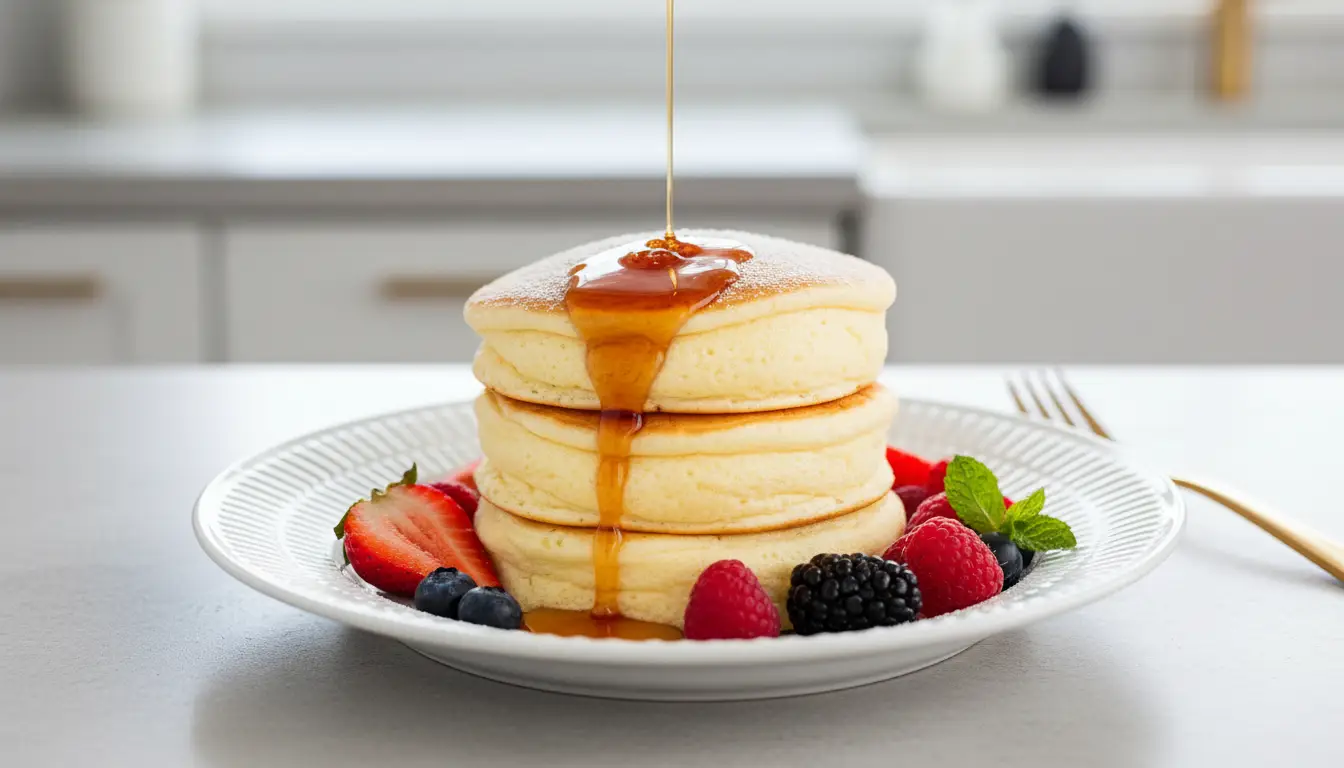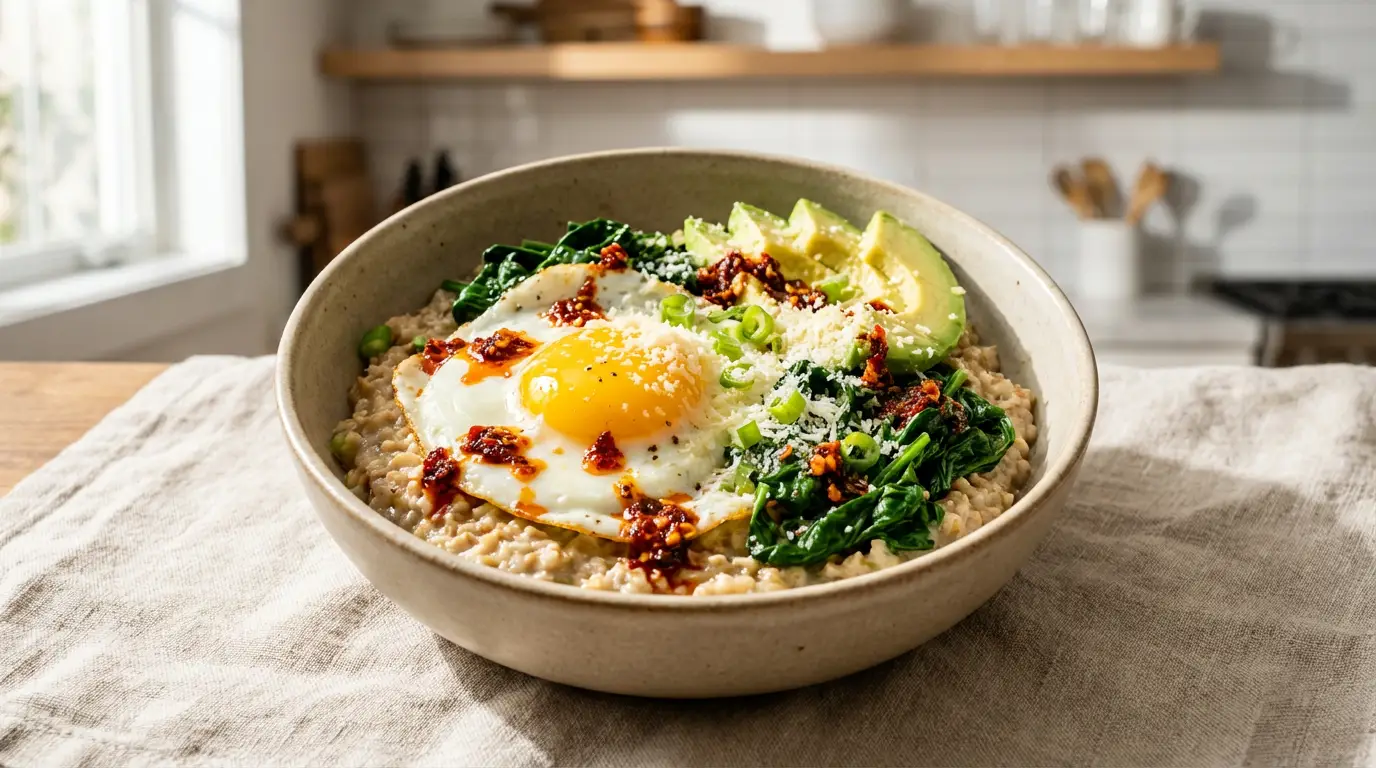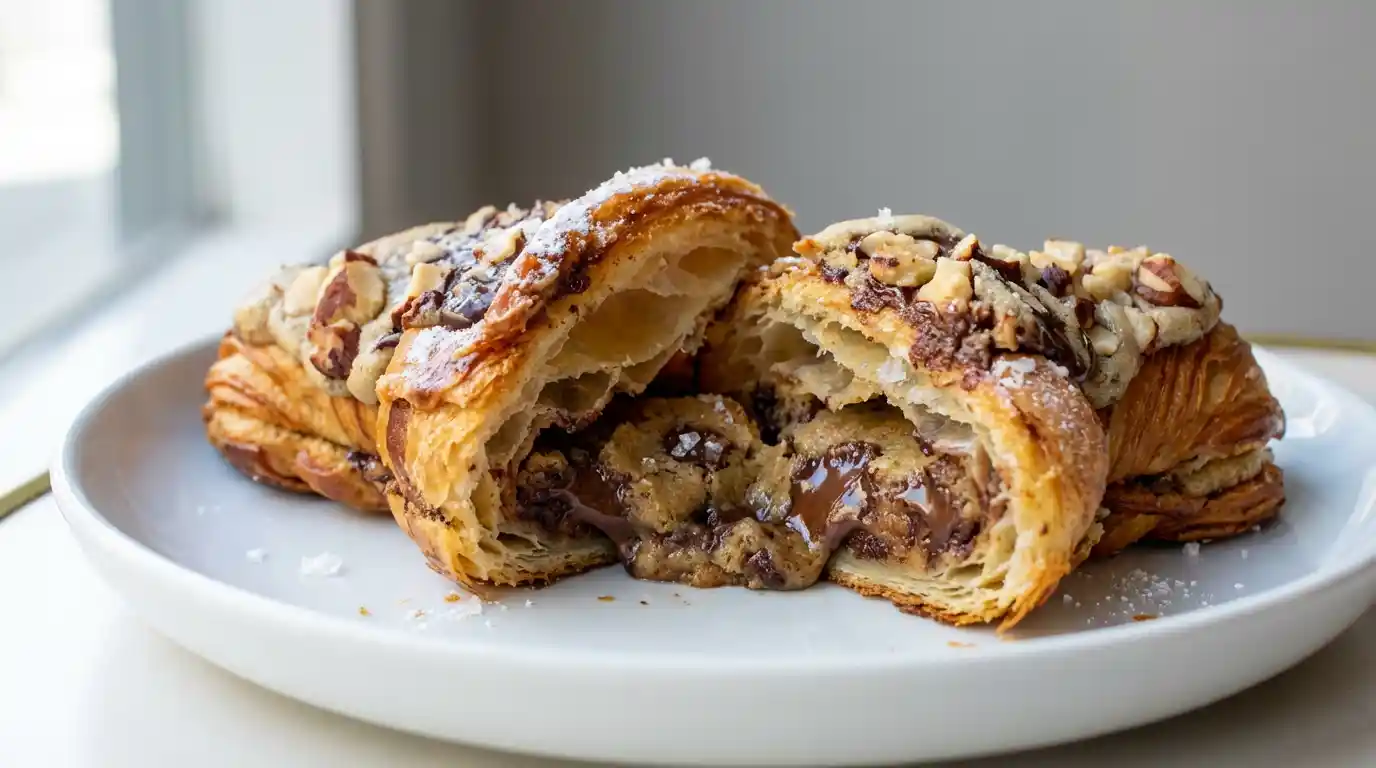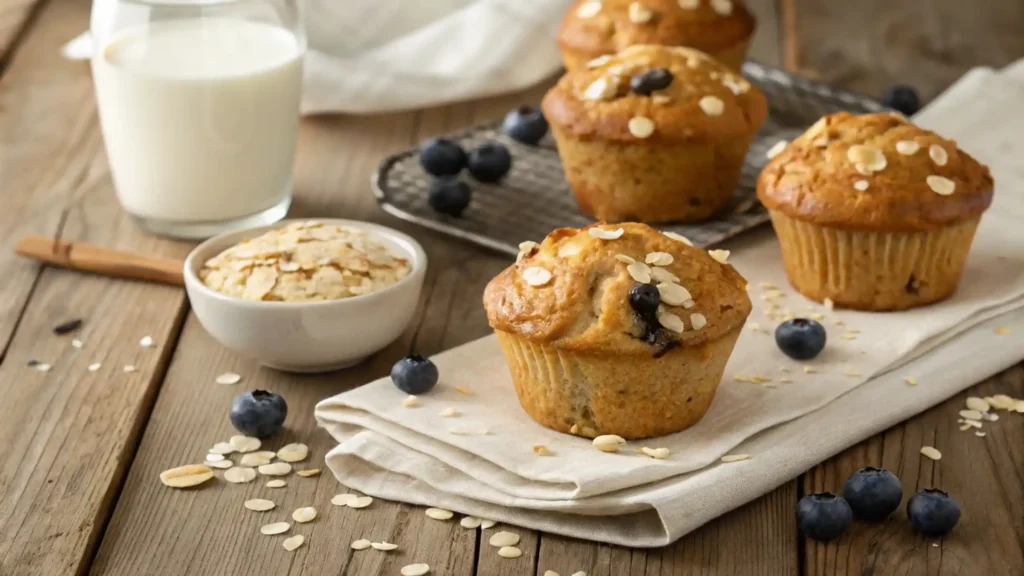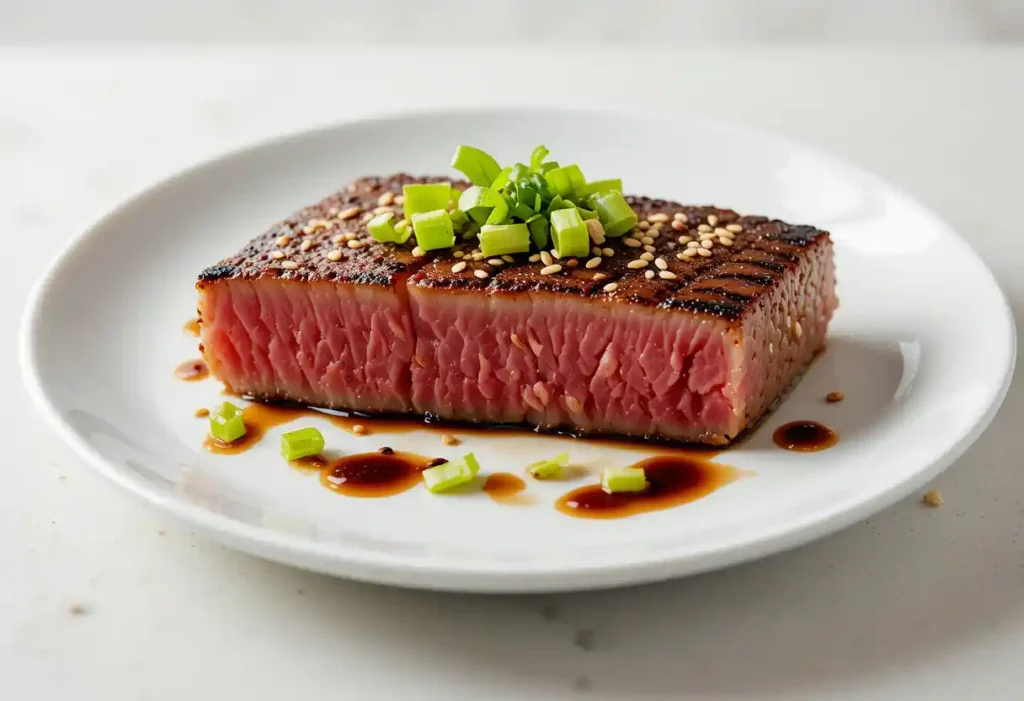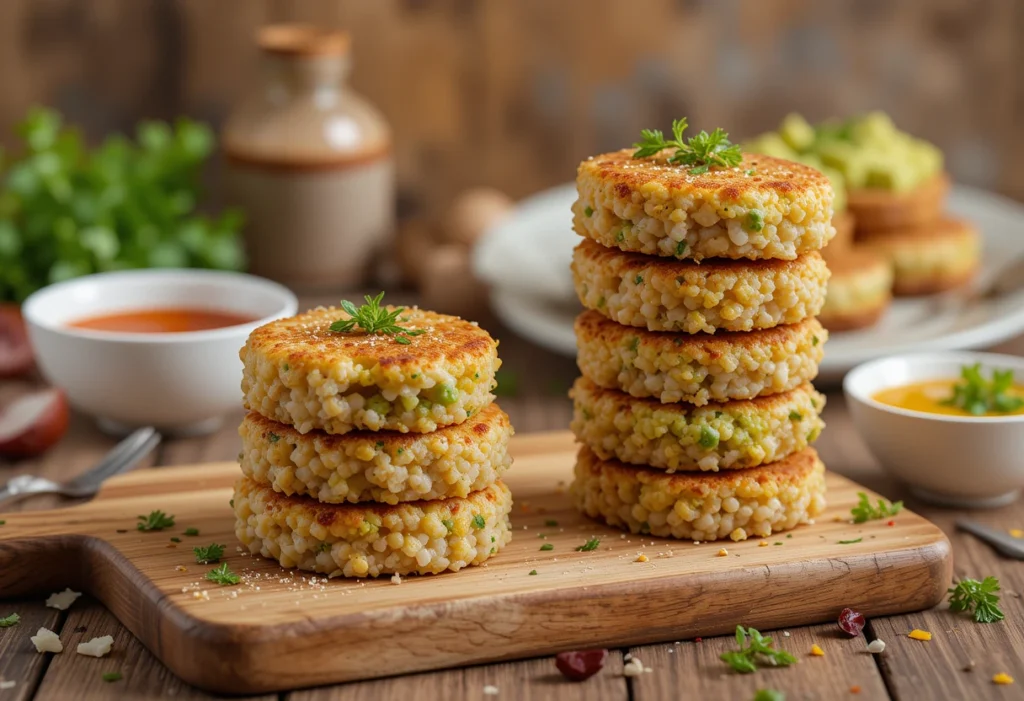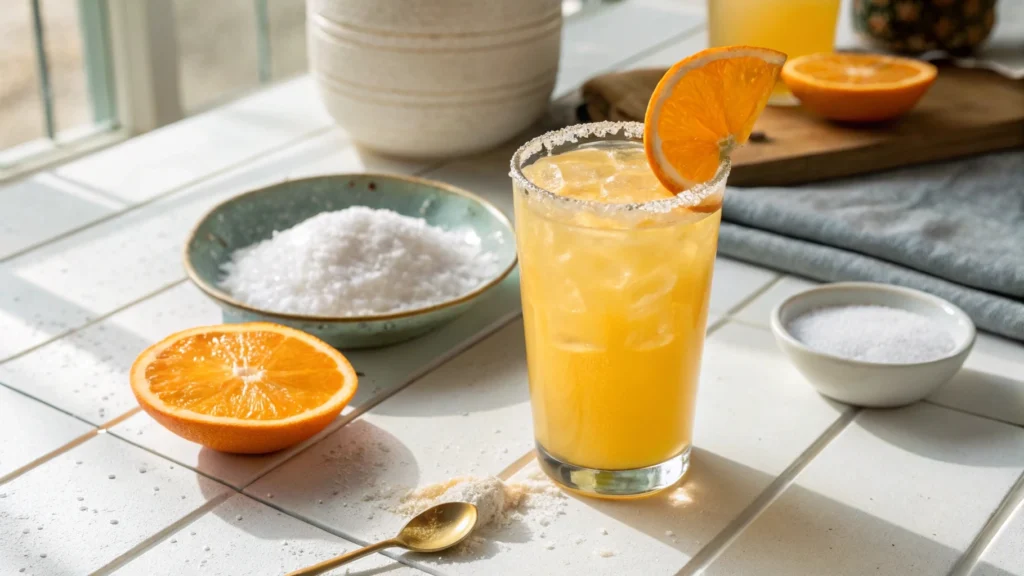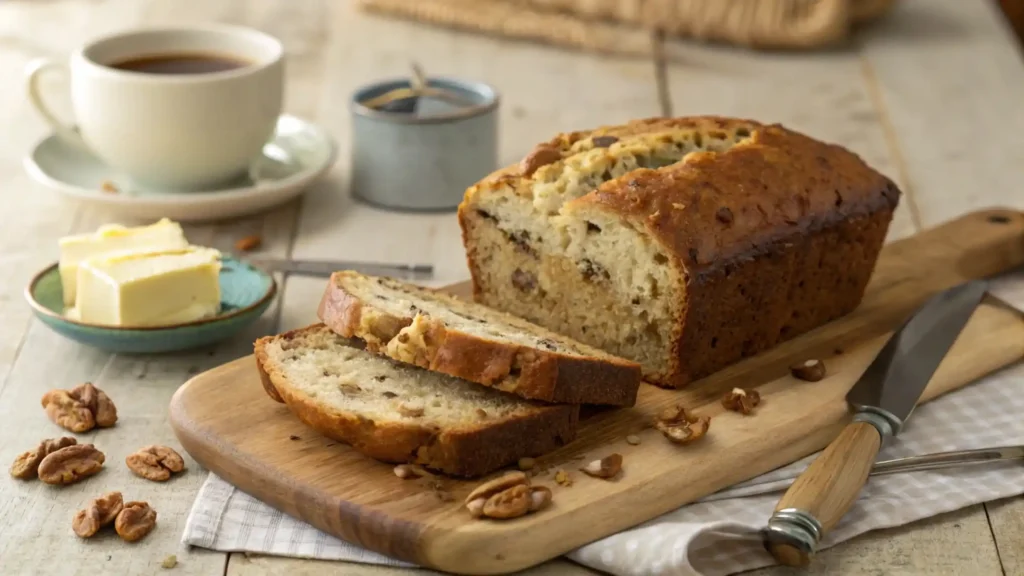Start your day with a warm, comforting treat that is easy to make and as good for your body as it is for your taste buds. These easy oatmeal muffins offer a balanced combination of whole grains, natural sweetness, and gentle spices. They are perfect for busy mornings or a wholesome snack at any time. In this guide, you will learn every step—from selecting the right ingredients and preparing the batter to adding creative twists such as blueberries and bananas, ensuring your muffins come out perfectly every time. Enjoy a recipe that is both simple and full of flavor, delivering a nutritious boost to your breakfast routine.
How to Make Oatmeal Muffins Perfectly?
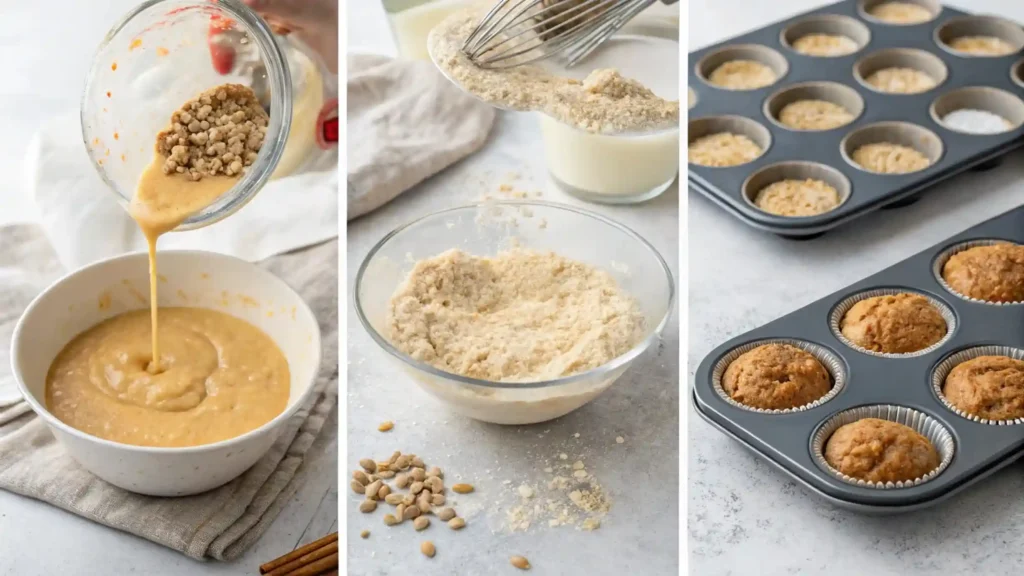
Creating these muffins involves selecting the best ingredients, mixing them with care, and baking until they reach a soft, golden finish. This section covers each crucial step in achieving muffins that are moist, tender, and full of natural flavor.
What Ingredients Are Essential for Easy Oatmeal Muffins?
Your journey toward perfect oatmeal muffins starts with gathering the right ingredients. The foundation of these muffins is oats. You may use old-fashioned rolled oats or quick oats, depending on your texture preference. Whole wheat flour or all-purpose flour provides structure, while baking powder and baking soda help them rise light and fluffy.
Key ingredients include:
- Oats: Use old-fashioned rolled oats for a chewy texture or quick oats for a smoother blend.
- Flour: Choose whole wheat flour for extra fiber or all-purpose flour if you prefer a lighter muffin.
- Leavening Agents: Baking powder and baking soda are necessary to give your muffins the right lift.
- Sweeteners: Brown sugar adds a natural sweetness with a touch of caramel flavor, while a drizzle of maple syrup can also be used.
- Spices: Cinnamon and a pinch of salt enhance the overall flavor profile without overpowering the natural oats.
- Wet Ingredients: Combine eggs, milk, and vegetable oil or applesauce to bind everything together and add moisture.
- Optional Add-ins: For extra texture and flavor, consider adding raisins, chopped nuts, or a mashed banana.
Using these ingredients in the right amounts ensures that your muffins have the proper balance of flavor and texture. The oats provide fiber and lasting energy, while the flour, eggs, and milk create a smooth batter that bakes evenly in a muffin pan. This combination also allows you to experiment with extra mix-ins, such as blueberries or chocolate chips, to customize the recipe to your taste.
What Is the Best Way to Prepare the Batter?
Achieving a smooth, well-mixed batter is crucial to the success of your oatmeal muffins. The process begins with correctly measuring your dry ingredients and combining them in a large, medium bowl. In one bowl, sift together the flour, oats, baking powder, baking soda, cinnamon, and a dash of salt. This ensures that the leavening agents are evenly distributed in the muffin batter, avoiding any clumps.
In a separate bowl, mix your wet ingredients. Beat the eggs until frothy, then stir in the milk, vegetable oil (or applesauce for a healthier option), and any extra liquid sweeteners like maple syrup. Gradually add the wet ingredients to the dry ingredients, stirring gently. Avoid over-mixing; a few small lumps are acceptable. Over-mixing may lead to tougher muffins rather than the soft, airy texture you desire.
For optimal results:
- Use a whisk to blend the wet ingredients before combining them with the dry.
- Use a spatula or wooden spoon to fold the wet ingredients into the dry mixture.
- Aim for a batter that is evenly moistened without becoming runny.
- If you plan to incorporate mix-ins such as blueberries or nuts, add them at the end with a gentle fold to distribute them evenly without breaking the fruit.
This method ensures that every muffin has the proper rise and texture, with the oats and flour creating a tender crumb that holds up well to the burst of flavors from any additional ingredients.
How to Know When Your Oatmeal Muffins Are Done?
A reliable test for muffin doneness is essential for perfect results every time. Here are the key signs that your muffins are ready:
- Color: The tops should be a soft, golden brown. The color indicates that the sugars in the batter have caramelized and the edges are set.
- Texture: The muffins should have a firm yet moist center. They should feel springy to the touch when pressed lightly.
- The Toothpick Test: Insert a toothpick into the center of one muffin. If it comes out clean or with just a few moist crumbs, the muffins are done.
- Rising: You will notice that the muffins have risen well, with a slight dome on top. This indicates that the leavening agents have worked correctly.
It is important to monitor the muffins during the last few minutes of baking. Oven temperatures may vary, so checking a minute or two before the recommended baking time with a toothpick inserted can help prevent overcooking. Allow your muffins to cool for a few minutes in the pan before transferring them to a wire rack. This step enables them to finish setting and makes them easier to remove from the muffin tin.
What Makes Blueberry Oatmeal Muffins Special?
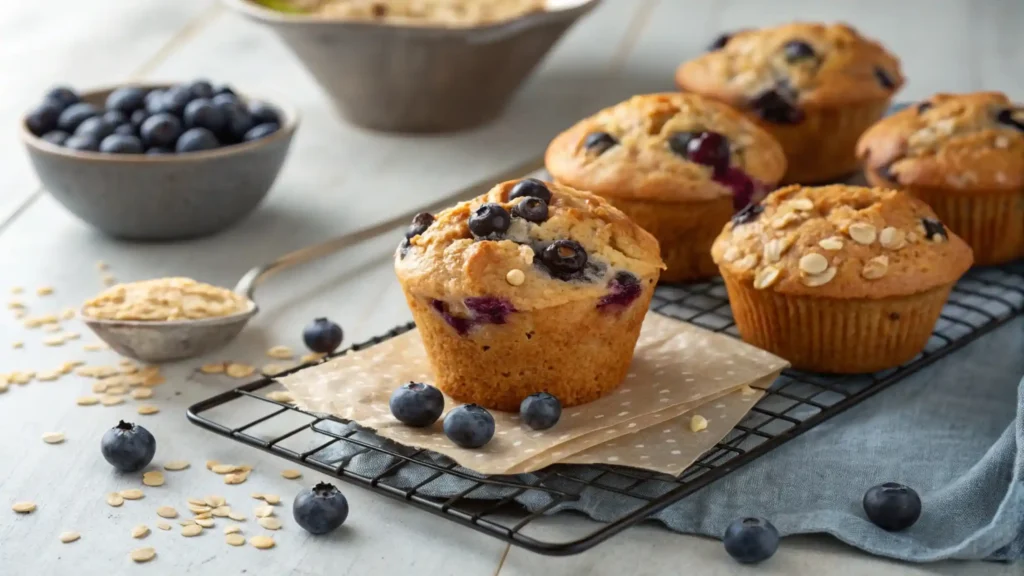
Blueberries add a burst of flavor and a pop of color to these classic oatmeal muffins. The natural sweetness and slight tartness of blueberries create a balanced taste that pairs perfectly with the earthiness of oats and the warmth of cinnamon. Blueberry oatmeal muffins are a delightful variation that brings freshness to your breakfast table.
How to Incorporate Blueberry into Your Muffins?
When adding blueberries, the method of incorporation is key. For the best results:
- Fresh Blueberries: Gently fold in the blueberries after the batter has been mixed. Distribute them evenly to prevent one side from becoming overly fruity.
- Avoid Over-Mixing: A soft touch is needed to ensure the berries remain whole. Over-mixing can bruise the blueberries and release too much juice, which might affect the consistency of the batter.
- Layering the muffin batter with blueberries at the top of the muffin creates a beautiful presentation. Consider adding a few blueberries on top of each muffin just before baking. This not only gives a pretty presentation but also bursts with flavor when you bite into them.
This method ensures that the blueberries stay intact and distribute their flavor evenly throughout the muffin.
Can You Use Frozen Blueberries in the Muffin Recipe?
Yes, frozen blueberries can be used. They are a convenient option, especially when fresh blueberries are not in season. Here are some tips for using frozen berries: Make sure to mix them with oats and milk for a delicious muffin batter.
- Thawing: You can use them directly from the freezer, but for a better result, allow them to thaw slightly and drain any excess liquid before folding them into the batter.
- Preventing Excess Moisture: If you add frozen blueberries without thawing, they may release extra water during baking, which can make the muffins soggy. To counter this, reduce the amount of additional liquid in the recipe by a small measure.
- Gentle Handling: Frozen blueberries can be more prone to breaking apart, so mix them into the batter with extra care.
Using frozen blueberries in your muffin recipe is a practical alternative. With these tips, your muffins will hold their shape and deliver bursts of blueberry flavor in every bite.
Tips for Creating the Best Blueberry Oatmeal Muffins
Achieving the perfect blueberry oatmeal muffin requires a few best practices:
- Distribute Evenly: Make sure to fill your muffin liners evenly for consistent baking and rising. Carefully fold the blueberries into the batter to ensure even distribution. This prevents the berries from sinking to the bottom.
- Top with Extra Berries: For an attractive look and enhanced flavor, place a couple of blueberries on the top of each muffin before baking.
- Monitor Moisture: Adjust the batter consistency if using frozen blueberries by reducing the milk slightly.
- Baking Time: Ensure the muffins do not over-bake. The added moisture from blueberries can extend the baking time slightly, so keep a close watch and use the toothpick test to check for doneness.
- Preheat the Oven: Always preheat your oven to ensure even baking throughout the muffin tin.
These careful steps will help you create blueberry oatmeal muffins that stand out with their delightful balance of moistness and flavor.
Are Healthy Oatmeal Muffins Truly Nutritious?
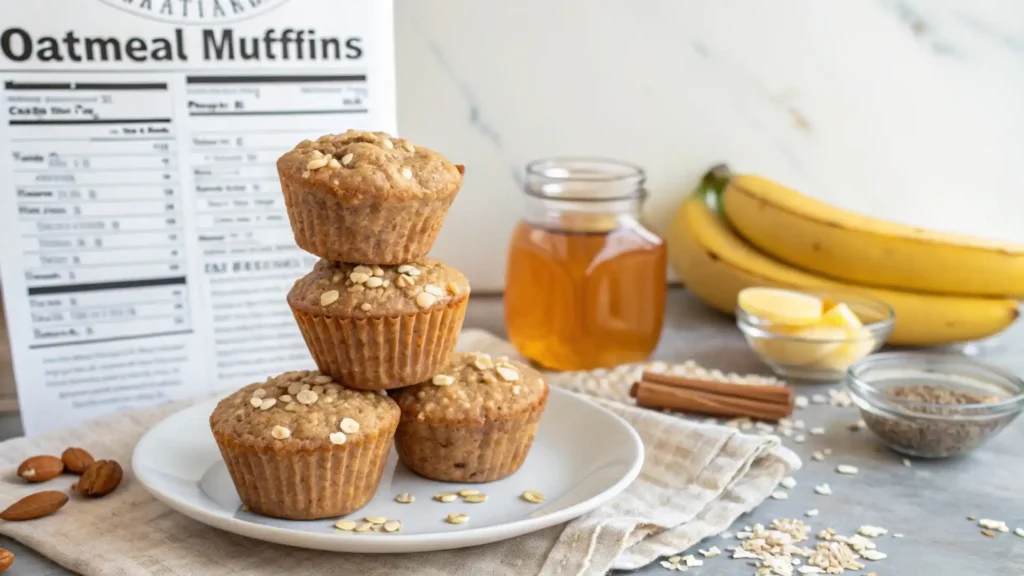
A key benefit of oatmeal muffins is their nutritional value. Made with whole grains, fruits, and natural sweeteners, they serve as a wholesome breakfast choice that supports a healthy lifestyle. This section delves into the nutritional benefits and how to adjust the recipe for even more health benefits.
What Makes Healthy Oatmeal Muffins Nutritious?
Healthy oatmeal muffins provide essential nutrients without unnecessary additives. The benefits include:
- Whole Grains: Oats provide fiber that aids digestion and supports heart health.
- Low-Fat Options: Consider using a combination of oats and milk to create a lighter muffin without sacrificing taste. Using applesauce or a small amount of vegetable oil lowers the fat content while maintaining moisture.
- Natural Sweeteners: Try using mashed bananas or applesauce muffins to naturally sweeten your baked goods. Brown sugar and a touch of maple syrup provide sweetness without the need for refined sugars.
- Extra Nutrients: Adding fruits like blueberries or bananas increases the vitamin and antioxidant content.
- Moderate Calories: These muffins are crafted as a nutrient-dense food, offering energy for your morning without excess calories.
Each ingredient works together to create a muffin that is not only tasty but also supports a balanced diet. The natural fiber in oats, along with the protein in eggs and the vitamins in fruit, makes these muffins a nourishing start to your day.
How to Substitute Ingredients for a Healthier Muffin Recipe?
You can make your muffins even healthier by substituting key ingredients:
- Oil Alternatives: You can also try using applesauce muffins as a healthier option for moisture. Replace vegetable oil with unsweetened applesauce to reduce saturated fat.
- Sweetener Swaps: Consider using maple syrup or natural stevia as a substitute for brown sugar. This change can lower overall sugar content.
- Flour Choices: Experiment with whole wheat flour in place of all-purpose flour to boost fiber and nutrient content.
- Dairy Options: Use low-fat or plant-based milk to suit dietary needs without sacrificing flavor in your muffin batter.
- Add Nutritious Extras: Incorporate mashed bananas or a handful of raisins to add natural sweetness and extra vitamins, making your breakfast muffins even more nutritious.
These adjustments allow you to keep the muffins delicious while aligning them with a balanced, health-conscious diet. Each substitution supports a lower-calorie, nutrient-rich recipe without losing the taste and texture you love.
Can Oatmeal Muffins Be a Part of a Balanced Diet?
Absolutely. Oatmeal muffins can easily become a part of your balanced meal plan:
- Breakfast Boost: They combine whole grains, protein, and fruit in one easy-to-eat package.
- Snack Option: Their portion size makes them perfect for a quick, sustaining snack that keeps energy levels stable.
- Portion Control: With mindful serving sizes, they fit well into a calorie-controlled diet.
- Nutritional Balance: The use of oats, lean proteins, and fresh fruits ensures that you get a mix of carbohydrates, proteins, and healthy fats.
When paired with a serving of yogurt or a small piece of fruit, these muffins contribute to a balanced intake of nutrients that supports both energy and overall wellness.
Can You Freeze the Muffins for Later Use?
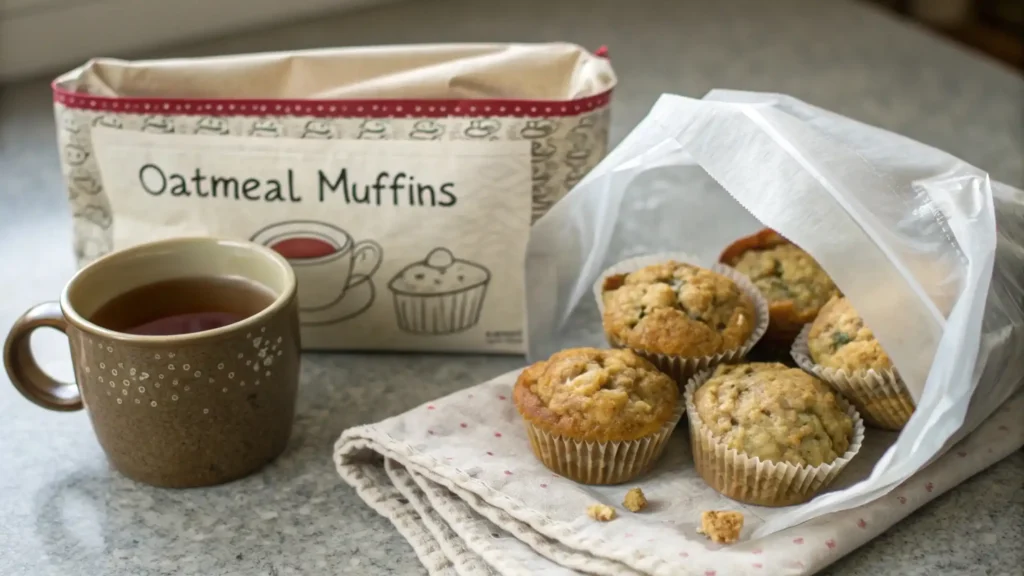
Oatmeal muffins are excellent for meal prep and can be frozen for later enjoyment. Whether you make a batch ahead of time or have extras to share, learning how to freeze and reheat them properly will preserve their flavor and texture.
What Is the Best Method to Freeze Muffins?
To maintain the quality of your muffins when freezing, follow these simple steps:
- Cool Completely: Allow your muffins to cool on a rack before freezing. This helps avoid condensation and soggy texture.
- Wrap Individually: Wrap each muffin in plastic wrap or aluminum foil. This protects them from freezer burn and keeps moisture in.
- Store in a Freezer-Safe Bag or Container: Place the wrapped muffins in an airtight container or freezer-safe bag. Label with the date for future reference.
- Avoid Overcrowding: Spread the muffins in a single layer if possible, to ensure even freezing.
This careful handling will lock in the flavor, ensuring that each muffin tastes as good as when it was first baked.
How Long Can You Store Muffins in a Freezer-Safe Bag?
Properly stored, oatmeal muffins can last in the freezer for up to three weeks. While they remain safe to eat beyond this period, their quality in terms of texture and taste may begin to decline. For the best results, try to use them within this window so that the freshness and flavor are at their peak.
How to Reheat Frozen Oatmeal Muffins?
Reheating your frozen muffins is straightforward:
- Thaw First: Remove the muffins from the freezer and allow them to thaw at room temperature for about 15–20 minutes.
- Reheat in the Oven: Preheat your oven to a moderate temperature (around 350°F). Place the muffins on a baking sheet and heat for 10–12 minutes. This method revives the muffin’s texture, keeping the crust slightly crisp.
- Alternative Microwave Method: If you are in a hurry, use the microwave on a low setting for 30–45 seconds per muffin. Note that microwaving may soften the crust of your muffins, so if texture is important, the oven method is preferable for baking mini muffins.
With these steps, your muffins will reheat evenly, ensuring that every bite is as good as when freshly baked.
What Are Some Variations of Oatmeal Muffins?
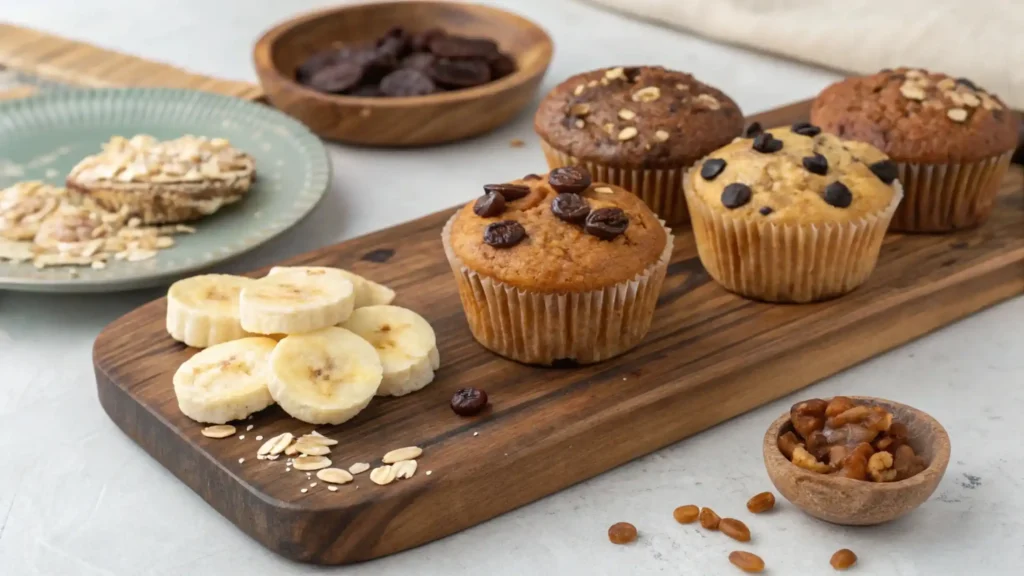
While the basic oatmeal muffin recipe offers a solid foundation, you can add creative twists to suit different tastes or nutritional goals. Experiment with additional fruits and flavors to create variations that keep your breakfast routine interesting.
How to Make Banana Oatmeal Muffins?
Banana oatmeal muffins add natural sweetness and moisture to your muffins:
- Mash the Banana: Use a ripe mashed banana to blend into your batter. This increases moisture and adds a subtle, sweet flavor.
- Mix Evenly: Fold the mashed banana into the wet ingredients before combining them with the dry ingredients. The banana will merge smoothly with the oats and flour.
- Extra Flavor: A dash of cinnamon along with the banana can enhance the natural sweetness and create a warm flavor profile.
Banana oatmeal muffins are soft, moist, and perfect for those who enjoy the distinctive taste of banana in a healthy treat.
Can You Add Chocolate Chips to Your Muffins?
Yes, adding chocolate chips is a fun way to introduce a bit of indulgence. Here’s how to do it: prepare your muffin batter using quick-cooking oats for a delightful texture.
- Measure Carefully: Ensure you have all your ingredients, including oats and milk, for the best results. Add about a half cup of chocolate chips into the batter. This amount provides a subtle chocolate burst without overwhelming the oatmeal flavor.
- Fold Gently: Stir in the chocolate chips after you have mixed the batter. This ensures they remain evenly distributed in the muffins.
- Balance the Sweetness: Chocolate chips work well with the natural sweetness of the oats and brown sugar, giving a pleasing contrast in flavor and texture.
These chocolate chip oatmeal muffins offer a delightful mix of healthy and sweet, making them a favorite variant.
What Other Ingredients Can Be Used for a Unique Muffin?
There are many ways to add your own twist to oatmeal muffins:
- Raisins or Dried Cranberries: These add a burst of chewy sweetness.
- Nuts and Seeds: Chopped walnuts or almonds provide crunch and extra nutrients.
- Spices: Additional spices like nutmeg can create a warming flavor without extra sugar.
- Zest or Juice: Lemon or orange zest can brighten the muffin’s flavor.
- Other Fruits: Try diced apples or pear along with a sprinkle of cinnamon to create a spiced fruit muffin.
These variations allow you to enjoy a new taste each time while keeping the heart of the recipe intact.
Conclusion For Oatmeal Muffins The Best Easy Recipe
These easy oatmeal muffins are more than just a breakfast option—they are a versatile, nutritious treat that can be enjoyed any time of the day. Whether you stick with the classic recipe or try one of the creative variations, each step is designed to help you produce muffins that rise beautifully, deliver consistent flavor, and provide a satisfying start to your day. By carefully choosing your ingredients and following these detailed instructions, you make a delicious and healthy breakfast that fits perfectly into a balanced lifestyle.
Enjoy these muffins warm from the oven with a cup of your favorite beverage. They are also ideal for meal prep, thanks to their excellent freezing and reheating qualities, especially when using paper liners. With many variations and easy substitutions, you can experiment and adjust the recipe to your taste without compromising on health or flavor.
We hope this guide helps you create the ideal oatmeal muffin experience—whether you love the original version or enjoy adding blueberries, bananas, or chocolate chips for that extra twist. Every bite delivers nourishment, flavor, and the comfort of a homemade treat, whether you choose blueberry muffins or banana muffins.
Feel free to experiment with the recipe by incorporating your favorite ingredients while keeping the basic structure intact. These tips and detailed instructions provide a clear roadmap for a successful batch of blueberry muffins that you will look forward to sharing with family and friends. Enjoy your baking journey and the delightful treats you create!
Try this classic Banana Nut Bread Recipe by Paula Deen for another easy and delicious homemade baked good perfect for breakfast or snacking.
FAQs
Below are answers to some common questions about oatmeal muffins. These cover health concerns, ingredient choices, and common baking challenges.
Are oatmeal muffins good for you?
Yes, oatmeal muffins can be a healthy option. They provide fiber, protein, and essential nutrients from whole oats and additional ingredients such as fruits and nuts. Choosing natural sweeteners and whole grains helps to keep oat muffins nutritious.
What is the healthiest type of muffin?
The healthiest muffins are those made with whole grains, minimal refined sugar, and natural ingredients like fruits, nuts, and unsweetened dairy or alternatives, such as in banana muffins. Healthy oatmeal muffins that focus on nutrient-rich ingredients rank high among nutritious options.
What oats are best for making oat muffins?
Both old-fashioned rolled oats and quick oats work well. Rolled oats offer a chewier texture, while quick oats blend more smoothly into the batter. Your choice depends on your texture preference.
Can you use old-fashioned oats instead of quick oats in muffins?
Yes, you can use old-fashioned oats. They may result in a slightly chewier texture. If you prefer a softer muffin, you might consider soaking the oats slightly in the milk before mixing.
Is it OK to eat baked oats everyday?
Eating baked oats every day can be acceptable as part of a balanced diet. They are nutrient-dense, but portion control and overall variety in your meals are important to maintain balanced nutrition.
Are homemade muffins healthier than store-bought?
Homemade muffins allow you to control the ingredients, reduce additives, and use natural sweeteners. This makes them a healthier option compared to many store-bought varieties that may contain preservatives and refined sugars, especially when you use paper liners for easy cleanup.
Which flour is better for muffins?
Whole wheat flour is a nutritious choice as it provides extra fiber and nutrients. However, if you prefer a lighter texture, you can use all-purpose flour or a mix of both to balance health and texture.
Why are oats unsuitable for bread making?
Oats lack gluten, which is essential for the structure and elasticity required in bread making. They work well in muffins and other baked goods where a denser, heartier texture is acceptable.
Why are my oatmeal muffins dry?
Dry oatmeal muffins can result from over-baking or using too little fat or liquid in the recipe. Adjust the amount of wet ingredients in your muffin batter, ensure your oven temperature is accurate, and remove the muffins promptly when they pass the toothpick test to retain moisture.
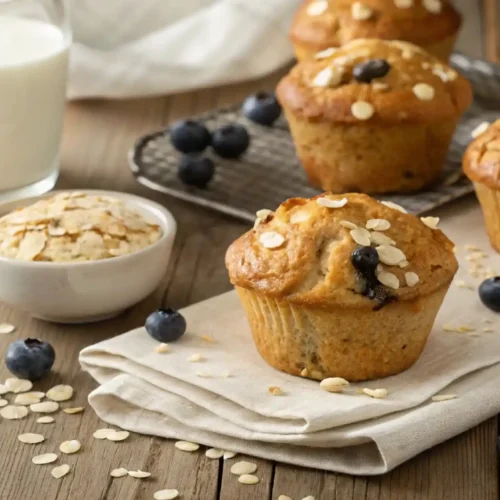
Oatmeal Muffins The Best Easy Recipe!
Ingredients
Ingredients (For 12 Muffins)
Dry Ingredients:
- 1 ½ cups old-fashioned rolled oats
- 1 cup whole wheat flour or all-purpose flour
- ⅓ cup brown sugar
- 1 ½ teaspoons baking powder
- ½ teaspoon baking soda
- 1 teaspoon ground cinnamon
- ¼ teaspoon salt
Wet Ingredients:
- 1 cup milk or almond milk
- 2 large eggs room temperature
- ⅓ cup vegetable oil or unsweetened applesauce
- 1 teaspoon vanilla extract
Optional Add-ins:
- ½ cup blueberries fresh or frozen
- ½ cup mashed ripe banana
- ⅓ cup chocolate chips
- ¼ cup raisins or chopped nuts
Instructions
Preheat the Oven
- Preheat oven to 375°F (190°C). Line a 12-cup muffin pan with paper liners or lightly grease with cooking spray.
Mix Dry Ingredients
- In a large bowl, whisk together rolled oats, flour, brown sugar, baking powder, baking soda, cinnamon, and salt.
Combine Wet Ingredients
- In a separate medium bowl, whisk the eggs. Then add milk, vegetable oil (or applesauce), and vanilla extract. Mix well.
Combine Wet and Dry Mixtures
- Slowly pour the wet mixture into the dry ingredients. Stir gently with a spatula until just combined. Avoid over-mixing.
Add Optional Mix-ins
- Gently fold in blueberries, mashed banana, chocolate chips, or raisins — based on your variation.
Fill the Muffin Pan
- Divide the batter evenly into the prepared muffin tin, filling each liner about ¾ full.
Bake
- Bake for 18-22 minutes, or until a toothpick inserted in the center of a muffin comes out clean.
Cool
- Let the muffins cool in the pan for 5 minutes, then transfer to a wire rack to cool completely.
Notes
Nutrition Information (Per Serving)
| Nutrient | Amount |
|---|---|
| Calories | 190 kcal |
| Fat | 6 g |
| Saturated Fat | 1 g |
| Protein | 5 g |
| Carbohydrates | 29 g |
| Fiber | 3 g |
| Sugar | 9 g |
| Sodium | 180 mg |


